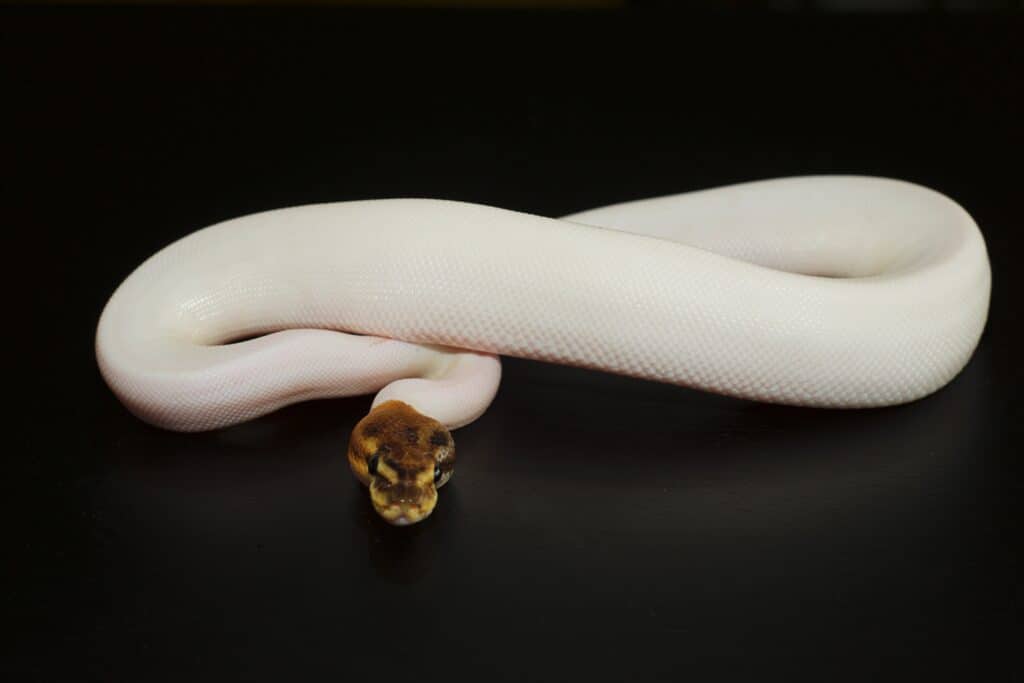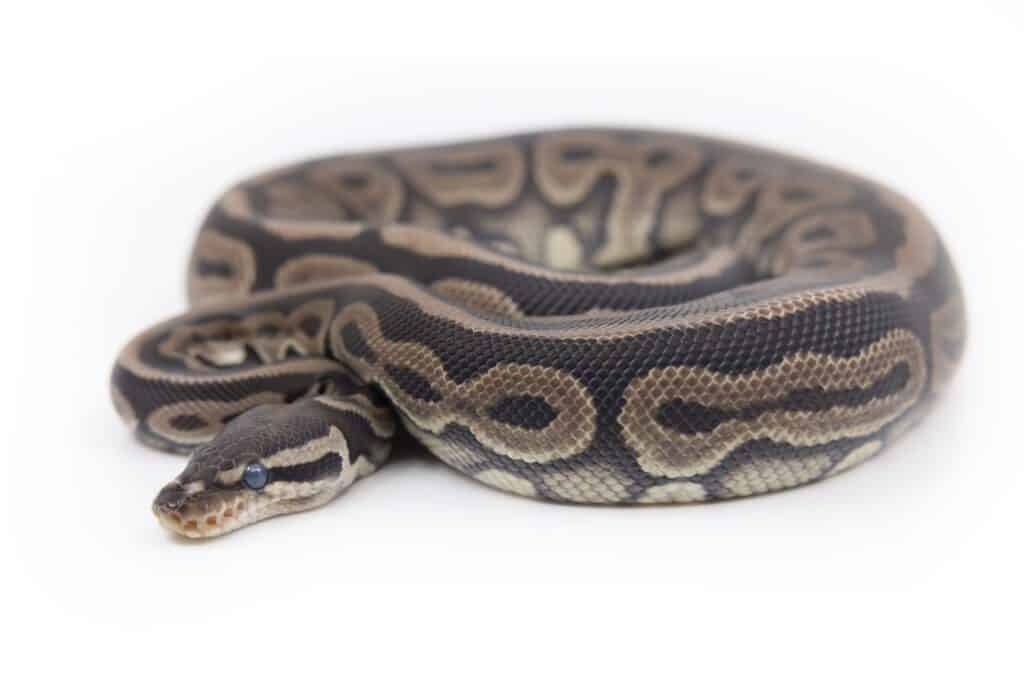Panda Pied Ball Python
Python regius
The panda pied ball python morph is a combination of the piebald and black pastel traits.
Advertisement
Panda Pied Ball Python Scientific Classification
- Kingdom
- Animalia
- Phylum
- Chordata
- Class
- Reptilia
- Order
- Squamata
- Family
- Pythonidae
- Genus
- Python
- Scientific Name
- Python regius
Read our Complete Guide to Classification of Animals.
Panda Pied Ball Python Conservation Status
Panda Pied Ball Python Facts
- Prey
- Rodents and birds
- Main Prey
- Rats and mice
- Group Behavior
- Solitary
- Fun Fact
- The panda pied ball python morph is a combination of the piebald and black pastel traits.
- Temperament
- Docile, curious, hardy
- Habitat
- Savanna, grassland, forests
- Diet
- Carnivore
- Lifestyle
- Nocturnal
- Favorite Food
- Rodents
- Common Name
- Panda pied ball python, Panda ball python
View all of the Panda Pied Ball Python images!
“The panda pied ball python morph is a stunning combination of the recessive piebald trait and the co-dominant black pastel trait.”
Panda Pied Ball Python Summary
Breeders have developed thousands of intricately detailed ball python morphs since the 1990s. In recent years, reptile breeders have been very creative when combining traits to create new morphs. The panda pied morph is a particularly unique-looking example, with its monochromatic white body contrasted by dark brown to black spots.
This striking morph was originally created and documented in 2008 by the breeders at Outback Reptiles. Breeders combined the recessive piebald and co-dominant black pastel traits. While the piebald trait breaks up the snake’s patterning with solid white patches, the black pastel trait typically produces a dark brown to solid black snake with no patterning.
When these traits successfully merge and pass on to a new clutch, the result is a distinctly panda-like ball python: solid white with black splotches that vary in size and placement.
3 Amazing Panda Pied Ball Python Facts
- The exact price of a panda pied ball python can vary depending on the specific expression of its patterning. For example, panda pied snakes with solid black heads and large black splotches tend to be valued more highly than those with smaller, more varied black spots.
- Additionally, their black splotches can vary from a dark, chocolaty brown to a cool jet black in color. This can also affect an individual snake’s pricing, as snakes with richer jet-black splotches are usually in higher demand than those with brown markings.
- As a designer morph that requires very specific conditions to reproduce, the panda pied morph cannot occur naturally in the wild.
Where to Find Panda Pied Ball Pythons
The standard, wild-type ball python (also known as the royal python) inhabits Sub-Saharan Africa, particularly central and western Africa. It can thrive in a wide range of habitats, including savannas, grasslands, and forested regions.
All ball python morphs belong to the same species. However, unlike many base morphs that can reproduce in nature, the panda pied is a designer morph that requires very specific captive breeding conditions to reproduce. Specifically, the piebald and black pastel traits must be crossed and passed on to create a clutch of panda pied babies.
Because the panda pied is a relatively newer morph with very unique, visually striking traits, it tends to be in high demand within the exotic pet trade. Outback Reptiles developed the first panda pied ball python in 2008, though many other breeders have developed their own lines since then.
Today, you can expect to pay anywhere from $1,500 to well over $3,500 for a single snake of this incredible morph! Keep in mind that snakes with large, darker black splotches and solid black heads tend to be the most expensive when compared to other possible color and patterning variations of the morph.
Scientific Name
Python regius, which translates to “royal python,” is this snake’s scientific name. The name is a reference to stories that female Egyptian royals wore ball pythons wrapped around their limbs as decoration.
Population & Conservation Status
The IUCN Red List has classified the ball python as near threatened, and it has been this way for about a decade. Although it is not currently imminently threatened with extinction, it could become endangered in the future.
Exact number estimates are difficult to discern, but populations within the snake’s native range have been decreasing in recent years. This is primarily due to habitat loss caused by the agricultural industry as well as the practice of hunting, trapping, and selling these animals.
How to Identify Panda Pied Ball Python: Appearance and Description
The panda pied ball python is an incredibly visually distinct morph in both color and patterning. The morph is a unique combination of the recessive piebald and co-dominant black pastel traits. The resulting snake retains the typical white piebald patterning and black pastel color splotches.
Generally, panda pied ball pythons have mostly white or cream-toned scales accented by dark brown or black splotches of varying size, shape, number, and location. Snakes with solid black heads and dark, cool-toned black splotches tend to be ideal, though many patterns and varying shades of dark brown, grey, and black are possible.
Aside from their color and patterning, panda pied snakes are otherwise morphologically identical to standard, wild-type ball pythons. They typically grow to around 3 to 5 feet long and have slightly elongated, triangular heads.
Keep these three traits in mind when identifying a panda pied ball python:
- Majority white or cream-toned scales
- Large splotches that can be dark brown to black and vary in size, shape, and location
- No patterning aside from brown/black splotches

The recessive piebald trait results in a white body and dark head.
©Keung/Shutterstock.com

Black pastel markings are the result of a co-dominant trait.
©Charnsitr/Shutterstock.com
Panda Pied Ball Python: How Dangerous Are They?
The ball python is not venomous. It is quite small in size at just 3 to 5 feet long, lacks fangs, and has fairly weak (yet very flexible) jaws. It hunts by ambushing prey and using constriction to subdue it. Typically, ball pythons hunt small rodents and birds, though they will also occasionally feed on small fish and amphibians.
In addition to lacking venom and fangs, ball pythons are generally docile towards humans. Their curious nature has made them incredibly popular within the exotic pet trade. In fact, the species’ common name is a reference to the snake’s tendency to curl its body tightly into a ball when startled or threatened. Since all ball python morphs belong to the same species, they tend to have the same general temperament.
In the unlikely event a ball python bites you, place the snake back into its enclosure before cleaning the wound. To speed up the healing process and prevent infection, be sure to bandage the wound. Most ball python bites do not cause significant medical issues.
Panda Pied Ball Python Behavior and Humans
The ball python is consistently popular and a well-loved pet reptile throughout the world. This is largely thanks to its small size and hardy yet docile and intelligent temperament. Ball pythons also have fairly simple care requirements and can thrive in enclosures as small as 50 to 60 gallons.
The panda pied morph remains one of the most prized and sought-after varieties of ball pythons. As a designer morph, it requires very specific conditions to produce in captivity and cannot occur naturally in the wild.
Related Animals
View all 192 animals that start with PPanda Pied Ball Python FAQs (Frequently Asked Questions)
Are panda pied ball pythons venomous?
Ball pythons are not venomous. They are constrictor snakes that lack fangs and have small, weak teeth.
How do panda pied ball pythons hunt?
Ball pythons are ambush hunters that kill their prey via constriction. They will lie in wait, usually well-camouflaged, and strike at the right moment when a rodent or bird happens to cross their path. They will then grab onto the prey animal and quickly coil their body around it, which suffocates the animal. Finally, the snake will swallow the prey animal whole with its flexible jaws and digest it slowly over the course of several days.
Are panda pied ball pythons aggressive?
Ball pythons, regardless of the morph, are generally regarded as non-aggressive towards humans. Rather than striking, they will typically curl into a ball or flee when threatened. Their docile, curious nature has made them popular pets amongst reptile enthusiasts of all experience levels.
Where do panda pied ball pythons live?
The standard, wild-type ball python is native to Sub-Saharan Africa, particularly in central and western Africa. The panda pied variety is a designer morph, so it does not occur naturally in the wild.
What do panda pied ball pythons eat?
Ball pythons typically eat small rodents and birds in the wild. However, they will also sometimes feed on small fish and amphibians. In captivity, it is common to feed them captive-raised mice and rats.
How much do panda pied ball pythons cost?
Panda pied ball pythons can vary in cost from around $1,500 to well over $3,000 depending on the snake’s exact patterning and color. As a relatively new designer morph, it remains in high demand and is one of the more expensive morphs on the market.
Are panda pied ball pythons rare?
The panda pied morph is quite rare and requires very specific breeding conditions to create in captivity. It is a designer morph and cannot occur naturally in the wild.
Thank you for reading! Have some feedback for us? Contact the AZ Animals editorial team.
Sources
- Oakland Zoo (1970) oaklandzoo.org/animals/ball-royal-python
- Professional Breeders (1970) probreeders.com/panda-piebald-pythons
- World of Ball Pythons (1970) worldofballpythons.com/morphs/panda-pied/
















